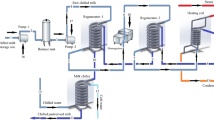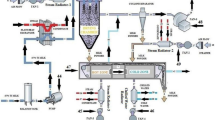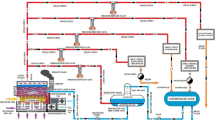Abstract
Cream is a milk derivative comparatively rich in fat, present in the form of emulsion of fat in skimmed milk, and acquired by physical extraction from raw milk with the help of centrifugal separator. The cream with variable fat content (10–40%) is commonly employed as an ingredient to traditional or modern desserts. It is also used in the production of value-added milk products such as butter and ghee apart from regular cooking applications. The pasteurisation, being an important safety requirement of milk food products, is usually materialised by heating the milk cream at a temperature of 90 °C for a period of one second. In the current work, thermodynamic and thermoeconomic derivatives in combination with all available constraints have been determined for high temperature short-time cream pasteurisation plant. The energy and exergy efficiency of cream pasteurisation plant was determined to be 86.88% and 66.11%, respectively. The cumulative value of energy destruction and exergy demolition in subunits of cream pasteurisation plant was estimated to be 93.88 kW and 11.39 kW, respectively, which mainly ascribed to complete enzymatic denaturation of fluid cream. The overall operating cost rate of complete cream pasteurisation plant was calculated as 1649.10 Rs./H, 22.02% portion of which was associated with electrical energy consumption. Further, the cost rate of exergy degradation for chilling and cooling activities was reported as 617.57 Rs./H and 357.55 Rs./H, respectively. The exergoeconomic factors of heating (14.75%) and chilling activity (0.82%) articulated that capital investment was dominant in the former while thermal degradations were enunciated most flagrant in latter.








Similar content being viewed by others
Abbreviations
- AC:
-
Annual cost of component (Rs.)
- \( \dot{C} \) :
-
Cost flow rate (Rs. H−1)
- c :
-
Exergetic cost (Rs. MJ−1)
- c f, k :
-
Unit exergetic cost of fuel (Rs. MJ−1)
- c p, k :
-
Unit exergetic cost of product (Rs. MJ−1)
- c p :
-
Specific heat (kJ kg−1 K−1)
- CRF:
-
Capital recovery factor
- D D, k :
-
Cost rate of exergy destruction (Rs. H−1)
- \( \mathop E\limits^{ \cdot } \) :
-
Energy (kJ s−1)
- \( \mathop {\text{EL}}\limits^{ \cdot } \) :
-
Energy loss rate (kW)
- E β, k :
-
Relative energy destruction ratio (%)
- Exβ, k :
-
Relative exergy destruction ratio (%)
- E F, k :
-
Energetic factor (%)
- ExF, k :
-
Exergetic factor (%)
- ex:
-
Specific exergy (kJ kg−1)
- \( \mathop {\text{Ex}}\limits^{ \cdot } \) :
-
Exergy rate (kW)
- \( \mathop {\text{Ex}}\limits^{ \cdot }_{\text{D}} \) :
-
Exergy destruction rate (kW)
- E IP :
-
Energy improvement potential (kW)
- ExIP :
-
Exergy improvement potential (kW)
- f :
-
Exergoeconomic factor of component
- h :
-
Specific enthalpy (kJ kg−1)
- H :
-
Hour
- I :
-
Interest rate (%)
- J :
-
Ratio of salvage value
- \( \mathop m\limits^{ \cdot } \) :
-
Mass flow rate (kg s−1)
- MF:
-
Milk fat
- PEC:
-
Purchase equipment cost (Rs.)
- PWF:
-
Present worth factor
- PW:
-
Present worth of component (Rs.)
- r :
-
Percentage relative cost difference (%)
- Rs. MJ−1 :
-
Rupees per mega-joule
- T :
-
Temperature (K)
- s :
-
Specific entropy (kJ kg−1 K−1)
- S :
-
Entropy (kJ K−1)
- S :
-
Salvage value (Rs.)
- SI:
-
Sustainability index
- TCI:
-
Total cost of investment (Rs.)
- TOCR:
-
Total operating cost rate (Rs. H−1)
- TPD:
-
Tons per day
- ν :
-
Specific volume (m3 kg−1)
- W :
-
Work rate (kW)
- \( \dot{Z}_{\text{T}} \) :
-
Levelised cost rate associated with capital investment and operation and maintenance cost (Rs. H−1)
- \( \dot{Z}_{\text{CI}} \) :
-
Levelised cost rate associated with capital investment (Rs. H−1)
- \( \dot{Z}_{\text{OM}} \) :
-
Levelised cost rate associated with operation and maintenance cost (Rs. H−1)
- HTST:
-
High temperature short time
- R :
-
Universal gas constant (8.314 kJ mol−1 K−1)
- ρ :
-
Density (kg m−3)
- \( \eta \) :
-
Energy efficiency (%)
- Ψ:
-
Exergy efficiency (%)
- 0:
-
Dead state
- €:
-
Euro
- Rs.:
-
Rupees (Indian currency)
- BT:
-
Balance tank
- CF:
-
Condenser and fan combination
- CHS:
-
Chilling section
- CS:
-
Cooling section
- HS:
-
Heating section
- HE:
-
Heat exchanger
- P1:
-
Pump-1
- P2:
-
Pump-2
- P3:
-
Pump-3
- P4:
-
Pump-4
- P5:
-
Pump-5
- RS:
-
Regeneration section
- ST:
-
Storage tank
- WT:
-
Water tank
- k :
-
Any component
- In:
-
Inlet
- Out:
-
Outlet
- T :
-
Total
References
Food and Agriculture Organization of the United Nations. Statistics Division. http://faostat3.fao.org/browse/Q/QP/E. Accessed 20 Oct 2017.
Bogh-Sorensen. T. Cream pasteurisation technology. In: Bulletin of the international dairy federation No. 297/1992, monograph on the pasteurisation of cream. Chapter 7. Brussels: International Dairy Federation; 1992. pp 32–9.
CII India Report: widening the scope of PAT scheme. 2013. http://shaktifoundation.in/wp-content/uploads/2017/06/widening-of-pat-sectors-dairy.pdf. Accessed 20 Oct 2017.
Dairy Processing Handbook. Sweden: Tetrapak Processing Systems. 1995. https://diaspereira.weebly.com/uploads/5/6/3/9/5639534/dairy_handbook.pdf. Accessed 20 Oct 2017.
Akinbami JFK, Ilori MO, Adeniyi AA, Sanni SA. Improving efficiency of energy use in Nigeria’s industrial sector: a case study of a beverage plant. Niger J Eng Manage. 2001;2(2):1–8.
Wall G. Exergy flows in industrial processes, Physical Resource Theory Group, Goteborg.In: Paper presented at the fourth international symposium on Second Law Analysis of Thermal Systems. Rome. 1987.
Hellstrom D. Exergy analysis of nutrient recovery processes. Water Sci Technol. 2003;48(1):27–36.
Fadare DA, Nkpubre DO, Oni AO, Falana A, Waheed MA, Bamiro OA. Energy and exergy analyses of malt drink production in Nigeria. Energy. 2010;35(12):5336–46. https://doi.org/10.1016/j.energy.2010.07.026.
Nasiri F, Aghbashlo M, Rafiee S. Exergy analysis of an industrial-scale ultrafiltrated (UF) cheese production plant: a detailed survey. Heat Mass Transf. 2017;53(2):407–24. https://doi.org/10.1007/s00231-016-1824-3.
Mojarab Soufiyan M, Dadak A, Hosseini SS, Nasiri F, Dowlati M, Tahmasebi M. Comprehensive exergy analysis of a commercial tomato paste plant with a double-effect evaporator. Energy. 2016; 111: 910–22. https://doi.org/10.1016/j.energy.2016.06.030.
Dowlati M, Mojarab Soufiyan M, Aghbashlo M. Exergetic performance analysis of an ice cream manufacturing plant: a comprehensive survey. Energy. 2017; 123:445–59. https://doi.org/10.1016/j.energy.2017.02.007.
Genc M, Genc S, Goksunger Y. Exergy analysis of wine production: red wine production process as a case study. Appl Therm Eng. 2017;17:511–21. https://doi.org/10.1016/j.applthermaleng.2017.02.009.
Pandey AK, Tyagi VV, Tyagi SK. Exergetic analysis and parametric study of multi-crystalline solar photovoltaic system at a typical climatic zone. Clean Technol Environ Policy. 2013;15:333–43. https://doi.org/10.1007/s10098-012-0528-8.
Pelvan E, Ozilgen M. Assessment of energy and exergy efficiencies and renewability of black tea, instant tea and ice tea production and waste valorization process. Sustain Prod Consump. 2017;12:59–77. https://doi.org/10.1016/j.spc.2017.05.003.
Basaran A, Yilmaz T, Civi C. Application of inductive forced heating as a new approach to food industry heat exchangers. J Therm Anal Calorim. 2018. pp. 1–18. https://doi.org/10.1007/s10973-018-7250-7.
Singh G, Singh PJ, Tyagi VV, Pandey AK. Thermal and exergoeconomic analysis of a dairy food processing plant. J Therm Anal Calorim. 2018. pp 1–18. https://doi.org/10.1007/s10973-018-7781-y.
Prabakaran R, Mohan Lal D. A novel exergy based charge optimisation for a mobile air conditioning system. J Therm Anal Calorim. 2018;132:1241–52. https://doi.org/10.1007/s10973-018-6998-0.
Ayub I, Munir A, Amjad W, Ghafoor A, Nasir SM. Energy and exergy based thermal analyses of a solar bakery unit. J Therm Anal Calorim. 2018;133:1001–13. https://doi.org/10.1007/s10973-018-7165-3.
Paradeshi L, Mohanraj M, Sriniwas M, Jayaraj S. Exergy analysis of direct expansion solar assisted heat pumps working with R22 and R433A. J Therm Anal Calorim. 2018;132:1241–52. https://doi.org/10.1007/s10973-018-7424-03.
Pandey AK, Tyagi VV, Rahim NA. Thermal performance evaluation of direct flow solar water heating system using exergetic approach. J Therm Anal Calorim. 2018;121:1365–73. https://doi.org/10.1007/s10973-015-4566-4.
Rashidi S, Javadi P. Esfahani J.A. Second law of thermodynamics analysis for nanofluids turbulent flow inside a solar heater with ribbed absorber plate. J Therm Anal Calorim. 2018. pp. 1–13. http://doi.org/10.1007/s10973-018-7164-4.
Kwak HY, Kwon YH, Oh S-D, Kim SM. Exergoeconomic analysis of thermal systems. Energy. 1998;23(5):393–406.
Tsatsaronis G. Recent developments in exergy analysis and exergo-economics. Int. J Exergy. 2008;5(5/6):489–99. https://doi.org/10.1504/IJEX.2008.020822.
Lazzaretto A, Tsatsaronis G. SPECO: a systematic and general methodology for calculating the efficiencies and costs of thermal system. Energy. 2006;31:1257–89.
Atmaca A, Yumrutas R. Thermodynamic and exergoeconomic analysis of a cement plant: part I—Methodology. Energy Convers Manage. 2014;79:790–8. https://doi.org/10.1016/j.enconman.2013.11.053.
Atmaca A, Yumrutas R. Thermodynamic and exergoeconomic analysis of a cement plant: part II—Methodology. Energy Convers Manage. 2014;79:799–808. https://doi.org/10.1016/j.enconman.2013.11.054.
Jafaryani JM, Aghbashlo M, Mohtasebi SS. Comprehensive exergy analysis of an industrial-scale yogurt production plant. Energy. 2015;93:1832–51.
Jekayenfa SO. Ergonomic evaluation and energy requirements of bread operations in south western Nigeria. Nutr Food Sci. 2008;38(3):239–48. https://doi.org/10.1108/00346650810871920.
Balkan F, Colak N, Hepbasli A. Performance evaluation of a triple-effect evaporator with forward feed using exergy analysis. Int J Energy Res. 2005;29(5):455–70. https://doi.org/10.1002/er.1074.
De Monte M, Padoano E, Pozzetto D. Waste heat recovery in a coffee roasting plant. Appl Therm Eng. 2003; 23: 1033–44. https://doi.org/10.1016/S1359-4311(03)00033-4.
Aghbashlo M, Kainmehr MH, Arabhosseini A. Energy and exergy analyses of thin-layer drying of potato slices in a semi-industrial continuous band dryer. Dry Technol. 2008;26(12):1501–8. https://doi.org/10.1080/07373930802412231.
Amjad W, Hensel O, Munir A, Esper A, Sturm B. Thermodynamic analysis of drying process in a diagonal-batch dryer developed for batch uniformity using potato slices. J Food Eng. 2016;169:238–49. https://doi.org/10.1016/j.jfoodeng.2015.09.004.
Park SR, Pandey AK, Tyagi VV, Tyagi SK. Energy and exergy analysis of typical renewable energy systems. Renew Sustain Energy Rev. 2014;30:105–23. https://doi.org/10.1016/j.rser.2013.09.011.
Mahmood A, Parshetti GK, Balasubramanian R. Exergy, energy and techno-economic analyses of hydrothermal oxidation of food waste to produce hydro-char and bio oil. Energy. 2016;102:187–98. https://doi.org/10.1016/j.energy.2016.02.042.
Luo X, Hu J, Zhao J, Zhang B, Chen Y, Mo S. Improved exergoeconomic analysis of retrofitted natural gas based cogeneration system. Energy. 2014; 72:459–75. https://doi.org/10.1016/j.energy.2014.05.068.
Gurturk M, Oztop HF, Hepbasli A. Comparison of exergoeconomic analysis of two different pearlitic expansion furnaces. Energy. 2015;80:589–98. https://doi.org/10.1016/j.energy.2014.12.015.
Ozdil NFT, Tantekin A. Exergy and exergoeconomic assessment of an electricity production system in a running waste water treatment plant. Renew Energy. 2016;97:390–8. https://doi.org/10.1016/j.renene.2016.05.039.
Oni AO, Fadare DA, Adeboye LA. Thermo-economic and environmental analyses of a dry process cement manufacturing in Nigeria. Energy. 2017;135:128–37. https://doi.org/10.1016/j.energy.2017.06.114.
Pandey AK. Exergy analysis and exergoeconomic evaluation of renewable energy conversion systems. Ph. D Thesis. Katra: Shri Mata Vaishno Devi University. 2013.
Mojarrab SM, Aghbashlo M, Mobli H. Exergetic performance assessment of a long-life milk processing plant: a comprehensive survey. J Clean Prod. 2017; 140(2): 590–607. http://dx.doi.org/10.1016/j.jclepro.2015.11.066.
Holman JP. Analysis of experimental data. In: Holman JP, editor. Experimental methods for engineers. Singapore: McGraw-Hill; 2001. p. 48–143.
Wojdalski J, Kaleta A, Drozdz B, Chojnacka A. Factors influencing the energy efficiency of dairy processing plant. Teka Comm Mot Energ Agric. 2012;12(1):307–13.
Walstra P. Physical Chemistry of Foods. Marcel Dekker, Inc. 2nd ed. New York (USA); 2003. Available from: http://www.flavours.asia/uploads/7/9/8/9/7989988/physical_chemistry_of_foods_www.ebookbyte.com.pdf. Accessed 20 Oct 2017.
Fushimi C, Kansha Y, Aziz M, Mochidzuki K, Kaneko S, Tsutsumi A. Novel drying process based on self-heat recuperation technology. Dry Technol. 2010;29(1):105–10. https://doi.org/10.1080/07373937.2010.482719.
Acknowledgements
The author would like to acknowledge the support provided by Verka Milk Plant, Mohali, Punjab (India), and greatly appreciate the plant management and technical staff for their cooperation throughout the evaluation phase.
Author information
Authors and Affiliations
Corresponding author
Additional information
Publisher's Note
Springer Nature remains neutral with regard to jurisdictional claims in published maps and institutional affiliations.
Rights and permissions
About this article
Cite this article
Singh, G., Singh, P.J., Tyagi, V.V. et al. Exergy and thermoeconomic analysis of cream pasteurisation plant. J Therm Anal Calorim 137, 1381–1400 (2019). https://doi.org/10.1007/s10973-019-08016-y
Received:
Accepted:
Published:
Issue Date:
DOI: https://doi.org/10.1007/s10973-019-08016-y




